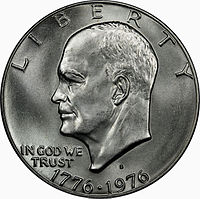
Back Moedas do bicentenario dos Estados Unidos Galician Monetazione del Bicentenario degli Stati Uniti Italian 美国二百周年纪念币 Chinese





The United States Bicentennial coinage is a set of circulating commemorative coins, consisting of a quarter, half dollar and dollar struck by the United States Mint in 1975 and 1976. Regardless of when struck, each coin bears the double date 1776–1976 on the normal obverses for the Washington quarter, Kennedy half dollar and Eisenhower dollar. No coins dated 1975 of any of the three denominations were minted.
Given past abuses in the system, the Mint advocated against the issuance of commemorative coins starting in the 1950s. Beginning in 1971, members of Congress introduced bills to authorize coins to honor the United States Bicentennial, which would occur in 1976. The Mint, through its director, Mary Brooks, initially opposed such proposals, but later supported them, and Congress passed legislation requiring the temporary redesign of the reverse of the quarter, half dollar and dollar.
A nationwide competition resulted in designs of a Colonial drummer for the quarter, Independence Hall for the half dollar and the Liberty Bell superimposed against the Moon for the dollar. All three coins remain common today due to the quantity struck. Circulation pieces were in copper nickel; Congress also mandated 45,000,000 part-silver pieces be struck for collectors. The Mint sold over half of the part-silver coins before melting the remainder after withdrawing them from sale in 1986.